Quick search
CTRL+K
Quick search
CTRL+K

Chicago is one of the great cities in USA, and it is beautifully located at the shores of Lake Michigan. The city’s parks and skyscrapers create a skyline that is only seen a few places in the world. Here, the urban, eastern United States meets with the vast agricultural lands, forests and prairie of the Midwest, and just that strategically good location has attracted millions of residents since Chicago with 350 people became a city in 1833.
Chicago stands in the history of architecture as one of the pioneers of modern high-rise buildings, and the Chicago school made its mark on many places in the world, such as in New Zealand’s Auckland. Chicago itself, though, is the best place to admire the early-20th-century skyscrapers, which became ever higher over the years to top it with Sears Tower; the present Willis Tower.
Chicago is also a very vibrant city when it comes to cultural activities. Here you will find prestigious museums, gastronomic delights and shopping in the usual American top class. Spiced with its beautiful location and a variety of green oases, it is never far to the next attraction and recreational opportunity. One of the most visited locations is Navy Pier, which extends into Lake Michigan.
Looking over the colossal Lake Michigan is also unforgettable and you can almost forget that Chicago is in the middle of the country. Lake Shore Drive and the coast are tremendous assets to the city and all its visitors. You can also make excellent day trips from Chicago. The city of Milwaukee and other places along Lake Michigan are obvious sightseeing destinations, and in the history of the state of Illinois can be seen in the capital of Springfield.
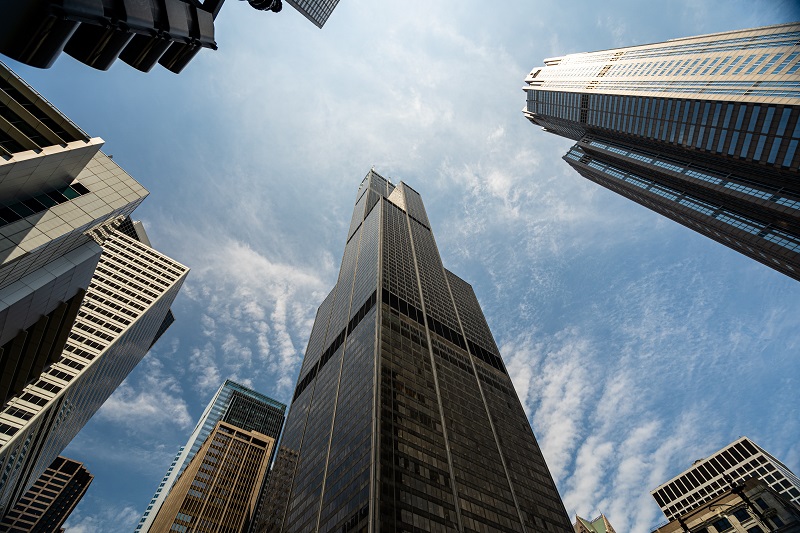
Willis Tower is the name Chicago’s and one of the world’s tallest buildings. There are no fewer than 110 floors here, and the height is 442 meters to the roof and 527 meters to the top of the highest antenna. The tower was constructed as the Sears Tower from 1970-1973 by the retail giant Sears, which gathered many of its Chicago-area employees in the new building. It was the world’s tallest until 1998. In 2009, insurance broker Willis moved into part of the tower, and with the accompanying naming rights, Sears Tower changed its name to Willis Tower.
On the 103rd floor there is an observation deck, the Skydeck, where at a height of 412 meters you can look out over Chicago and the surrounding area and far out into Lake Michigan to the east. At the height, there are also glass-bottomed balconies that extend out of the building and thereby make it possible to look down 412 meters vertically.

The Art Institute of Chicago is a distinguished art museum where you can see works in virtually every art form. The collection is large and represents thousands of years of art from around the world. You can enjoy works by European impressionists such as Claude Monet, post-impressionists and modern American painters like Edward Hopper, whose famous painting, Nighthawks, from 1942 is included in the collection.
African art, Asian art, great European masters of painting, furniture and sculptures are themes from other parts of the permanent exhibition.
The museum’s history goes back to the Chicago Academy of Design, which was founded as an art school in 1866 with its own art gallery. It was the forerunner of the Chicago Academy of Fine Arts, which in 1882 became the Art Institute of Chicago. The museum building was completed in 1893 making it possible to open during the second year of the World’s Columbian Exhibition. In 2009, a modern extension opened, where you can see, for example, works by Magritte, Matisse and Picasso.
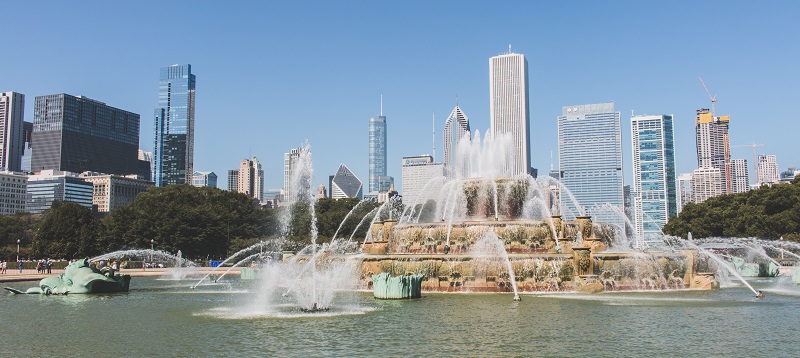
Buckingham Fountain is a large fountain built in 1927 in pink marble. The model was the French Sun King Louis XIV’s equivalent fountain at the Palace of Versailles outside Paris. Buckingham Fountain was however built much larger than the French version.
The water jumps up to a height of 40 metres, and on summer evenings there is a colorful light show in the water. From the green area around the fountain, Grant Park, there is a beautiful view of the Chicago skyline.
Officially, the fountain is called the Clarence Buckingham Memorial Fountain. It was donated to the city by Kate Buckingham as a monument to her brother Clarence. For TV series watchers from the 1990s, the fountain will bring back memories, as it formed the intro shots for the series Married with Children starring the character Al Bundy.
Water Tower is as the name indicates a water tower in central Chicago, and it is one of the few buildings that survived the great fire of 1871. The tower was built in 1869 in lime stone, and among the tall skyscrapers it most resembles a small European castle.
The water tower is now one of the landmarks of Chicago, and it is open as a visitor’s center. The 47 meter high water tower is the second oldest in the United States. Only the Louisville Water Tower in Kentucky is older. It was constructed in 1856.
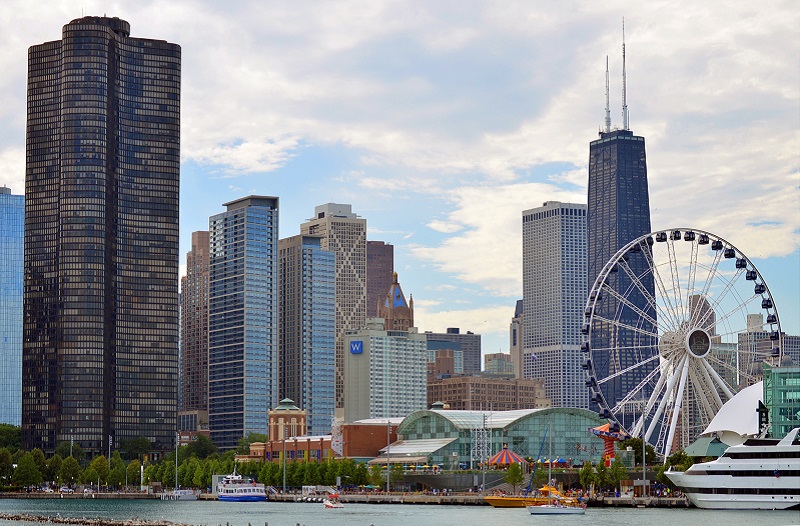
Navy Pier is a pier that was built as a result of the city plan of 1909. It included the construction of two long piers into Lake Michigan. Since its construction in 1914-1916, Navy Pier has extended 1,010 meters into the lake, while the second pier was never built. Initially, the official name was Municipal Pier #2.
The purpose of Municipal Pier #2 was to be able to dock cargo ships that sailed on Lake Michigan, and therefore warehouse buildings were also built for storage purposes. However, passenger ships should also be able to dock, and the pier was given its own tram line as a means of transport.
During World War I, the pier was also used by soldiers, and in 1927 it was named Navy Pier in honor of those who served here. With the Second World War, the navy returned to the pier, which had gradually become one of the residents’ most popular recreational attractions with restaurants, playgrounds, dance halls, and more.
Since the 1970s, a lot of entertainment has been opened at Navy Pier, which is today one of the city’s most visited places. There are quite a few different attractions at Navy Pier, and in addition to them, there are several boat tours that you can take from the pier.

Field Museum of Natural History is considered to be one of the world’s best natural history museums, and here you can also see a fine anthropological collection that was originally collected for the city’s great exhibition in 1893, World’s Columbian Exhibition. In total, there are millions of different objects in the rich collection of the institution.
Among the museum’s exhibits, you can see the most well-preserved Tyrannosaurus Rex in the world as well as several other dinosaur finds. Other natural history themes are mammals from Africa and Asia, life and biodiversity in the soil layer below us and the Earth’s development
You can also see treasures from Egypt at the Field Museum. In that part of the exhibition, you go down a shaft to a reconstructed burial chamber. There are also many cultural items from the Native American population and much more in the large museum.
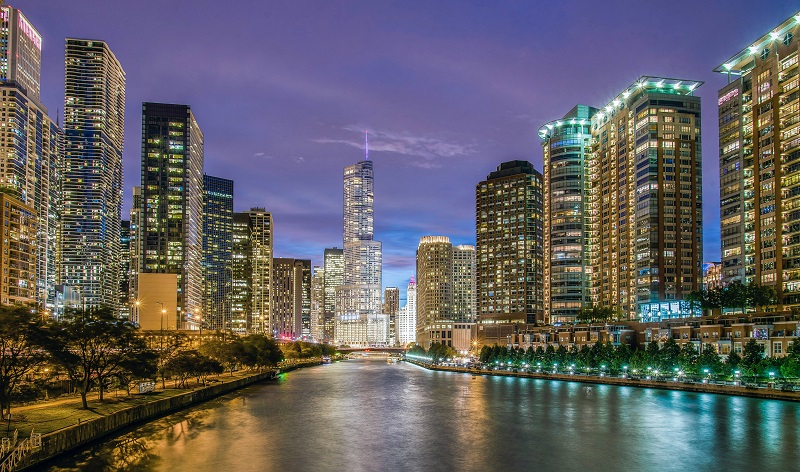
The Chicago River is a river that flows through downtown Chicago before entering Lake Michigan. Along the river there are some beautiful stretches with impressive views of many of the city’s skyscrapers such as the Wrigley Building and the Tribune Tower.
Several companies offer interesting boat trips on the Chicago River, which cuts through central Chicago and where you can get up close to the city’s architecture. The sky-high buildings look impressive and different from the waterside than on a stroll through the streets of the big city. A departure point can be the Navy Pier, but there are also other boarding points.

Union Station is a monumental railway terminal that was built in Beaux-Arts architecture in the years 1913-1925, and it replaced an earlier railway station from 1881. The new construction took place at a time when Chicago was the central railway hub of the USA with more than 300 trains a day. Before Union Station was built as a large main station that could connect Chicago’s traffic in one place, there were quite a few stations around the city. They took up space for the city’s expansion, and made it impossible to smoothly switch between the railway lines.
In 1874, five railway companies agreed that they would build a common railway station. It opened in 1881 as the first Union Station on the site where the Pittsburgh, Fort Wayne and Chicago Railroad had had a station since 1858. Union Station is the only one of Chicago’s great historic stations still in use. Both intercity trains and regional trains continue to run from here.
The central hall with its vaulted glass ceiling is one of the city’s most beautiful public spaces. There are 45 meters to the roof, and above that there are floors with offices. Originally, there was supposed to be a high-rise building on top, but only the lower floors were built.
After the construction of the railway station, they began to use the space above the tracks, and several houses have been built here since then. The first were the Daily News Building in 1929 and the Chicago Main Post Office in 1932, both constructed in the Art Deco style.
The Monadnock Building is a house famous for being the world’s tallest brick skyscraper, where, compared to modern skyscrapers, it is not the steel skeleton that supports the building. The Monadnock Building was constructed over two phases and was completed in 1891 and 1893 respectively. At the time of completion, the building was the largest office building on Earth, and the height of the 17 floors reached 66 meters.
There were several innovative measures during the construction. It was, for example, the city’s first office building to be equipped with electricity, and there was fire protection in the masonry, so that the internal metal frames and thereby the building’s supporting structures were protected.
By the 1930s, competition from new, tall skyscrapers was destroying the economic foundations of Chicago’s older and already outdated high-rises. With a large-scale renovation and modernization of the Monadnock Building, the building was once again at the forefront and was once again able to attract new tenants. From 1979 and the following many years, the building was restored to its original style and interior, and as a result it stands today as a beautiful monument from the 19th century high-rise buildings.
The Blackstone Hotel is Chicago’s most luxurious hotel from the early 1900s. It was built 1908-1910 and represents the French Beaux Arts style both inside and out. The hotel was named after the railwayman Timothy Blackstone, whose house was formerly located here.
The Blackstone Hotel was eventually called the Hotel of Presidents, as many American presidents have stayed here, including Woodrow Wilson, Theodore Roosevelt, Franklin D. Roosevelt, John F. Kennedy and Richard Nixon.

The Chicago Cultural Center is an exhibition and event building that offers a varied program in different art forms. Over time, the house has also hosted many official receptions, where the mayor of Chicago has welcomed heads of state and other important guests.
The building was built 1892-1897 as the city’s main library and museum. The place is characterized by an elegant interior in the best materials. Among the highlights of the architecture are the decorations around the staircases and the two domes, Grand Army of the Republic Memorial and Tiffany Dome.
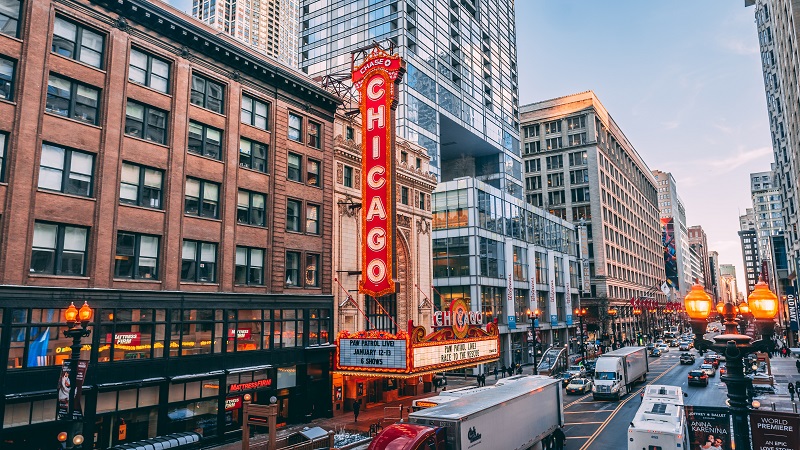
The 1921 Chicago Theater is a movie theater that was built as an American movie palace in the spirit of the time, with the grand ornamentation and proportions of grand premieres. The building style was Beaux Arts, and the cinema was built as one of the first buildings in this style in Chicago.
You can often see the neon sign with the letters Chicago on the theater’s facade reproduced in pictures that set the mood of the city. Therefore, the theater will seem familiar to most visitors as a Chicago icon.
Trump International Hotel and Tower is a 98-story skyscraper that features a hotel and apartments. The 423 meter high building opened in 2009 as Chicago’s and the USA’s second tallest, and it is named after Donald Trump, who later became president of the United States.
When Trump announced the construction in 2001, it was intended that the skyscraper would be the world’s tallest, but that plan was changed after September 11 of the same year. The Sixteen restaurant is one of the building’s facilities. It is located on the 16th floor and has a terrace from which the view of the area’s many well-known buildings and of the winding course of the Chicago River towards Lake Michigan is formidable.
Medinah Temple from 1912 is considered to be one of the USA’s most beautiful buildings with inspiration from Islamic, Middle Eastern style. The temple was built as an event venue with room for more than 4,000 spectators. The place’s acoustics were so good that many of the city’s symphony orchestra’s recordings have taken place here.
The building style was an interesting mix of the industrial looking buildings of the time and the beautiful ornamentation that characterizes Islamic architecture. Since 2003, the building has been used as a warehouse.
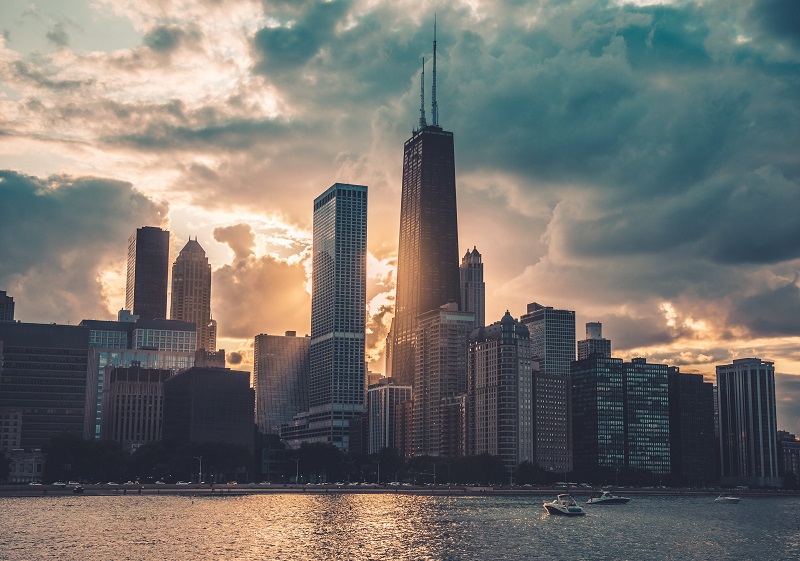
The 100-storey John Hancock Center was built as a distinctive high-rise in 1969. The building is called Big John, and it is 344 meters high. With the antennas, however, the top reaches 457 metres. On the 94th floor there is an observation deck from which you have a fantastic view of Chicago and Lake Michigan.
At the time of construction, the John Hancock Center was the tallest building in the United States outside of New York. The name comes from the first tenant, which was the John Hancock Life Insurance Company. Today, there are both offices and 700 apartments in the John Hancock Center.
The Museum of Contemporary Art is Chicago’s museum for contemporary art, and it contains more than 6,000 works from the period after 1945. The museum’s own collection includes paintings, installations, photographs and sculptures. The artists include Andy Warhol, René Magritte and many others.
The museum opened in 1967 and is today one of the largest of its kind in the world. The current museum building was opened in 1996 on the site where the National Guard’s former clothing store was located until 1993. The Berliner Josef Paul Kleihues designed the building with features from both modernism and the so-called Chicago school, which arose with high-rise buildings in the 1880s and 1890s.

Jackson Park is a green area located south of the Museum of Science and Industry and along Lake Michigan. The park is named after the seventh president of the United States, Andrew Jackson, who held the country’s leading office in the years 1829-1837.
In 1890, Chicago was designated to host the World’s Columbian Exhibition, established to celebrate the 400th anniversary of Christopher Columbus’s European rediscovery of America. After the exhibition in 1893, the area was turned into a park, and only a few things survived from the well-visited exhibition.
A preserved area from the world fair is the Japanese garden, Osaka Garden, located on the island in the park’s lagoon. South of this you can see the monument Statue of the Republic. The statue is a smaller replica of the 20 meter high original that graced the exhibition in 1893. The first statue was destroyed by fire in 1896 and the current one was erected in 1918.
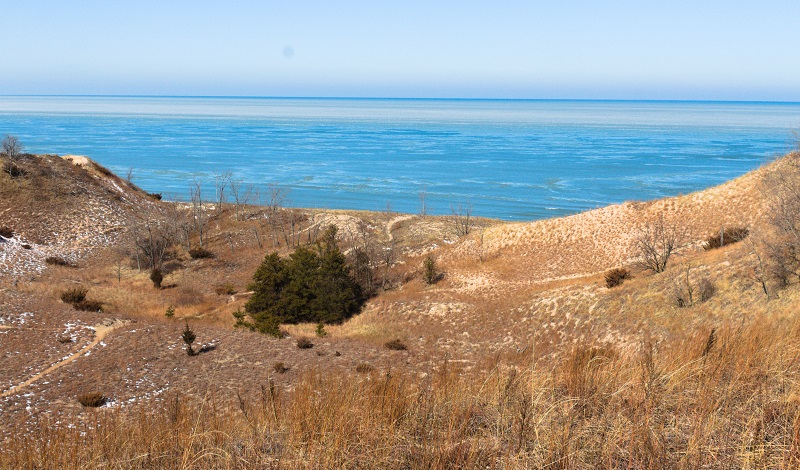
Some of the best beaches in the USA can perhaps surprisingly be found in the Indiana Dunes park along the shores of Lake Michigan. There are over 15 kilometers of sandy beaches in the area, and Lake Michigan’s area is so large that you feel like at the sea.
The Indiana Dunes are home to more than 350 different birds throughout the year, and there are more than 100 kilometers of hiking trails that offer the opportunity to really get close to the silence of the beautiful landscape, which is relatively close to the big city of Chicago, but yet so far away in the nature.
Michigan City is a city located on the shores of Lake Michigan with easy access to waterside recreation. There are a couple of lighthouses in the town, the Old Michigan City Light (Heisman Harbor Road) was built in 1858 and today it houses the Old Lighthouse Museum. In 1904, the lighthouse lantern was moved to the new lighthouse, Michigan City East Light, located on the city’s harbor pier with an old-fashioned iron bridge over the concrete pier.
Michigan City is also a railway town on one of the few remaining interurban rail lines in the United States, The South Shore Line, which cuts through the city in the middle of the streets. The South Shore Line opened in 1903, connecting the southern shore of Lake Michigan with Chicago.
Long Grove is a historic village and an experience with a great contrast to the skyscrapers of Chicago. It is almost like stepping into the 19th century Midwest. Here are more than 80 buildings from that time, and they count both houses from the country and from a small village, such as the elegant church from 1847. West of the center and towards the Long Grove Community Church, you can cross an original covered wooden bridge.
Long Grove was founded and developed after the opening of the Erie Canal between Albany and Buffalo, New York State in 1825. It allowed for easier emigration to the lush lands of the Midwest. In the 1840s, many German immigrants came to Long Grove, which was called Muttersholz until World War I, when an English name was introduced.

Milwaukee is the largest city in the US state of Wisconsin. The town’s history goes back to the first settler in the area, who was the French-Canadian Alexis Laframboise. He established a trading post here, and over the following decades, Byron Kilbourn, Solomon Juneau, and George H. Walker established the sites of Kilbourntown, Juneautown, and Walker’s Point. Juneautown was established east of the Milwaukee River in 1818, while Kilbourntown dates from 1834, and Byron Kilbourn fought Juneautown by establishing an asymmetrical street network that later required angled bridges.
It culminated with the so-called Bridge War in 1845 before the three cities were merged into Milwaukee the following year. In the next decades, many German settlers arrived, so that around 1880 the city consisted of a clear majority of Germans, and they left their mark on Milwaukee, which as an example of German influence became the home of the breweries Miller and Pabst. The city’s growth continued through the 1900s, with the population at one point reaching 700,000.

Madison is the capital city of Wisconsin, and it is a vibrant city with an interesting history and cultural sights. Founded in 1836 and named after James Madison, the fourth President of the United States, the city was strategically chosen for its location on an isthmus between Lakes Mendota and Monona. Over the years, Madison has grown from a small settlement into a bustling city with a pivotal role in the political life of Wisconsin. The city’s rich history is evident in its well-preserved buildings and landmarks you can explore today.
The most iconic building in Madison is the landmark Wisconsin State Capitol. It was completed in 1917 and stands as a majestic monumental structure in the Madison skyline with a dome inspired by the U.S. Capitol. It is also the tallest building in Madison. The Capitol’s interior is adorned with beautiful murals, marble from around the world, and a stunning rotunda. Visitors can take guided tours to learn about the building’s history and architecture while enjoying panoramic views of the city from the observation deck.
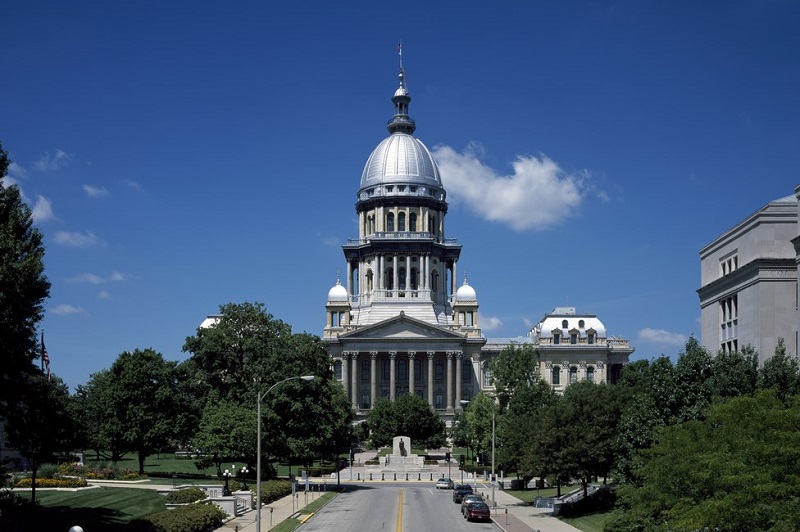
Springfield is the state capital of Illinois. The city was founded in 1821, and just 16 years later it became the state’s political center, not least thanks to the efforts of the young politician Abraham Lincoln. Since then, Springfield has been closely associated with the later American president, and this history forms an important part of the city’s attractions.
The state of Illinois’ current government building, the State Capitol, is the sixth of its kind in Illinois since the state’s admission to the United States in 1818. It was built 1868-1888. The building is 110 meters high, making it the tallest classical Capitol in the United States. The beautiful, zinc-clad dome measures 28 meters in diameter, and the style is French Renaissance.
New Salem State Historic Park is a state park near the city of Petersburg. The area pays tribute to Abraham Lincoln’s time in the city as a reconstruction of the village from the 1830s, where Lincoln lived for six years and shaped his young adulthood. A visit is, in addition to the story of Abraham Lincoln, interesting because it gives an impression of a village from the early years of the United States.

Indianapolis is the capital and largest city of the US state of Indiana. The city’s history began when Indiana became a state in 1816, when the state donated federal land to establish a new government city. The first settlers came to the area in 1819 or 1820, and the city was named Indianapolis in 1821. That same year, the first city plan was designed, and the establishment of the city began. In 1827 the National Road came to town, and 20 years later the first railroad opened to Indianapolis.
After the American Civil War, the city boomed as a railway junction and through meat production, and in 1890 the population reached 100,000. At the beginning of the 20th century, growth and prosperity continued with a large automobile production, and in 1910 the famous Indianapolis 500 motor race was held for the first time. Throughout the century there was great construction activity in the city, which in recent decades has revitalized the downtown area.

Lansing is the capital city of Michigan, and it is an interesting destination with a rich modern history starting in the early 1800s. The area was first surveyed in 1825, but it wasn’t until the winter of 1835-1836 that the first settlement, known as Biddle City, was plotted by two brothers from New York.
The initial settlement was often flooding, and Biddle City was abandoned because of that. However, the area was later renamed Lansing Township in honor of the brothers’ hometown in New York, and the town grew. The turning point for Lansing came in 1847 when it was chosen as the new state capital, a decision driven by its central location and the wish to move the capital away from Detroit.
900 North Michigan Avenue
shop900.com
900 North Michigan Avenue
bloomingdales.com
700 North Michigan Avenue
chicago-place.com
1650 Premium Outlets Boulevard, Aurora
premiumoutlets.com
6170 West Grand Avenue, Gurnee
gurneemillsmall.com
111 North State Street
macys.com
35 North Michigan Avenue
shopwatertower.com
Schaumberg
gowoodfieldmall.com
Michigan Avenue (Mignificent Mile)
Adler Planetarium & Astronomy Museum
1300 South Lake Shore Drive
adlerplanetarium.org
Brookfield Zoo
First Avenue/Ogden Avenue
brookfieldzoo.org
Chicago Children’s Museum
700 East Grand Avenue
chicagochildrensmuseum.org
Field Museum of Natural History
1400 South Lake Shore Drive
fieldmuseum.org
Kiddieland
8400 West North Avenue, Melrose Park
kiddieland.com
Lincoln Park Zoo
Lincoln Park, 2200 North Cannon Drive
lpzoo.com
Shedd Aquarium
1200 South Lake Shore Drive
sheddaquarium.org
Six Flags Great America
Grand Avenue, Gurnee
sixflags.com/greatamerica
Museum of Science & Industry
57th Street/Lake Shore Drive
msichicago.org
In the present-day Chiacago area, several tribes lived as European colonization began on the North American continent. Mascoute, Miami, Potawatomi and Illinois are all names of people who had connections with each other through trade and seasonal hunting.
In the area itself along Lake Michigan, there were mainly Potawatomi people who, along with the European settlement, crowded other tribes to the west. Like many other places in the United States, the tribes have given names to the geography of modern USA. For example, the word Chicago comes from the Illinois-Miami language designation Shikaakwa, which refers to onion plants that grow along the Chicago River. Likewise, the state of Illinois’ name comes from the tribe.
With the help of local Indians, French Jesuit monk Jacques Marquette and Canadian explorer Louis Jolliet explored the first European area of present-day Chicago; Their journey took place in 1673. It then became a French mission in 1696, but due to the turmoil and attacks of the locals, the area was abandoned in the 1720s.
Thus, the first permanent settlement was only founded a little later when Jean Baptiste Point du Sable of Santo Domingo established a settlement and trading station at the mouth of the Chicago River in 1781. He was himself the first resident of the strategically good site with access to Lake Michigan and huge natural resources to the north and west. In 1795, the first of the country was officially transferred by the original population to the state of the United States.
At Du Sable’s settlement, Fort Dearborn was built in 1803. It was to be a defense against the attacking Native tribes that regularly housed the area. After many times attacking the fort, the Indians were finally defeated in 1832, with the Americans winning over Chief Black Hawk. As a result, a significant obstacle to further growth and development was cleared.
With the victory over the Indians, the area had settled down, and Chicago with 350 residents was officially upgraded to the status of a city in 1833. The following year, the schooner Illinois made the quay. It came from Sackets Harbor in the state of New York and marked the start of important commercial traffic across Lake Michigan.
Quite quickly many farmers arrived, and their harvest crops were transported by the newly constructed roads to Chicago’s port for shipping; Often, New York was the target of the crops. The population increased, and by 1837 it had reached 4,000.
The first railroad to Chicago was opened from Galena in 1848, and in a few years railways were built from all directions to the city at Lake Michigan. That same year, the Illinois & Michigan Canal Waterway was opened, connecting it to the Mississippi River and the Gulf of Mexico.
With all these transport routes, Chicago’s role as one of the United States’ absolute traffic hubs was established. Agricultural products and timber from the areas north and west of Chicago were processed in the city and passed on to the cities to the east, and the favorable situation led to colossal growth and immigration to the city. Trading companies flourished on the big turnover, and companies like Sears and Montgomery Ward saw the light of day.
The population almost exploded during this period. Out of 350 people in 1833, about 30,000 lived here just 17 years later, and within ten more years, the number was around 100,000. By 1870, Chicago had grown to the second largest city in the United States with more than 300,000 inhabitants.
A large part of Chicago’s physical growth has been through the use of wood as a building material. Most buildings, sidewalks and other things were thus easily ignited if the accident should occur, as it did in 1871. Here, in the midst of the great growth period of the 19th century, the city was hit by an extensive fire that left large parts of the city desolate. In total, over 17,000 buildings were lost and in the center there were only a few buildings that survived. A third of the inhabitants were also homeless, while about 300 died as a result of the fire.
A great deal of reconstruction work was started, and already a few weeks after the fire, the first new buildings began to be erected. The large, devastated areas and a conscious choice of materials other than wood enabled the use of the space at height to a greater extent than before. Chicago, therefore, became the site that pushed the United States skyscraper scare. Innovative construction methods were applied in response to the soft and swampy subsoil of Lake Michigan. Steel skeletons were the answer, and by 1885 the world’s first modern skyscraper was complete; it was the nine-story high Home Insurance Building.
Steel skeletons were also used to secure better traffic in the city a few years later. The iconic subway, the L, opened in 1892 and has since acted as a backdrop in a sea of films. In the rapidly growing city, the track was constructed as bridges over the existing street network, providing the desired accessibility.
The new builds were to be built at a speed in the thriving city, which, with its good location, trade, production and logistics, merely attracted European immigrants and people from the eastern states of the United States. From the fire of 1871 to the year 1900, the population increased from 300,000 to 1,700,000.
The city had literally risen from the ashes and sat down further on the world map with the holding of the World Exhibition’s Columbian Exposition in 1893. It happened on the occasion of the 400th anniversary of Christoffer Columbus’s trip to America. The exhibition became a staging piece with 27.5 million visitors and pavilions in styles that sparked the country’s beaux-arts construction in the following years.
Chicago’s near-constant growth resulted in the first major, overall city plan in 1909. The plan was called The 1909 Chicago Plan, but due to the many intended boulevards and parks, it was also known as the mind of the Prairie’s Paris / Paris on the Prairie. With the city plan, the city evolved from a fast-growing, large settler community to a planned and rapidly growing, modern metropolis. The results of the plan include the city’s central parks and the Navy Pier.
With more residents and increasingly economic importance, the central areas of Chicago had risen dramatically in value in the late 1800s. Growth constantly brought new building wishes into the center, and the solution was higher and taller buildings. Of course, with the many new residents, the city also expanded, and suburb after suburb was established in those decades, with people from large parts of Europe and blacks from the southern United States being among those who settled in ethnic neighborhoods like many other places in the country. .
World War I started in Europe, and later came the Prohibition. Events that infected Chicago in the 1920s became home to syndicates and others who found a lucrative business in smuggling spirits from Canada. Among the best known leaders were Al Capone and Frank Nitti, and over the years there were ongoing meetings between the rival groups.
The 1920s again became a decade of new and higher skyscrapers. Art deco won in style, and the city’s economy and activity grew with construction. The stock market crash in 1929 and the depression in the 1930s, as in the rest of the world, left its mark on the activity, and for many decades not many new skyscrapers were built.
In the heavy economy of the 1930s, however, there were also bright spots. For example, in 1933, the city’s 100th anniversary was celebrated with the exhibition Century of Progress, which attracted more than 40 million guests. The theme of the exhibition was technological development in Chicago’s time, and it provided hope and inspiration in a time when the positive news was not in line.
During those years, parts of the secret Manhattan Project also took place in Chicago, whose university on December 2, 1942 became the home of the world’s first controlled nuclear chain reaction. An event that helped create a new foundation for the military development of the following decades and for the world’s energy production.
After the end of World War II, a development with increased relocation from central neighborhoods to the suburbs that sprang up like mushrooms came in line with the expansion of highway networks and local railways. During the same period, in the 1950s, the labor market also changed with many job reductions in the industry. Chicago’s population dropped and poor neighborhoods emerged; something new in the city’s history.
In response to the problems, the city council adopted the so-called Plan 21, which sought to bring about improvements in the poor areas by turning them into a kind of suburban city. The public constructed new housing that should be attractive to move to.
In the 1950s, Chicago’s infrastructure was greatly expanded with not least the large network of freeways, but investments were also made to maintain the city’s status as one of the entire US traffic hubs. The city built the international O’Hare airport as a replacement for Midway, and O’Hare quickly developed into one of the world’s busiest locations for the rapidly increasing air traffic.
The trip also came to the somewhat worn-out city center, where a new skyscraper scare started. The buildings reached new heights, and the best known was the world’s tallest building, the Sears Tower, which was completed in 1973. The AON Center and John Hancock Center from this time also remain among the country’s and the world’s tallest skyscrapers.
In recent decades, there has been a lot of activity in Chicago’s downtown, which in turn has begun to attract new residents. New buildings are constantly being fired, including the Trump International Hotel and Tower, and lovely leisure and activity facilities are being built along Lake Shore Drive. New is a higher degree of environmental action; such as the many gardens set on top of the flat skyscrapers.
Major events are also held on an ongoing basis in Chicago. When the soccer world championships were held in the United States in 1994, the city was host to the opening match, which was followed by billions around the world. Concerts, theatrical performances and prestigious exhibitions at the city’s museums are also part of the experience of today’s Chicago, which has reached farther than most from the start with 350 inhabitants in 1833.
 Chicago
Chicago
Overview of Chicago
Chicago is one of the great cities in USA, and it is beautifully located at the shores of Lake Michigan. The city’s parks and skyscrapers create a skyline that is only seen a few places in the world. Here, the urban, eastern United States meets with the vast agricultural lands, forests and prairie of the Midwest, and just that strategically good location has attracted millions of residents since Chicago with 350 people became a city in 1833.
Chicago stands in the history of architecture as one of the pioneers of modern high-rise buildings, and the Chicago school made its mark on many places in the world, such as in New Zealand’s Auckland. Chicago itself, though, is the best place to admire the early-20th-century skyscrapers, which became ever higher over the years to top it with Sears Tower; the present Willis Tower.
About the Whitehorse travel guide
Contents: Tours in the city + tours in the surrounding area
Published: Released soon
Author: Stig Albeck
Publisher: Vamados.com
Language: English
About the travel guide
The Whitehorse travel guide gives you an overview of the sights and activities of the Canadian city. Read about top sights and other sights, and get a tour guide with tour suggestions and detailed descriptions of all the city’s most important churches, monuments, mansions, museums, etc.
Whitehorse is waiting for you, and at vamados.com you can also find cheap flights and great deals on hotels for your trip. You just select your travel dates and then you get flight and accommodation suggestions in and around the city.
Read more about Whitehorse and Canada
Canada Travel Guide: https://vamados.com/canada
City tourism: https://visitwhite-horse.ca
Main Page: https://www.vamados.com/
Buy the travel guide
Click the “Add to Cart” button to purchase the travel guide. After that you will come to the payment, where you enter the purchase and payment information. Upon payment of the travel guide, you will immediately receive a receipt with a link to download your purchase. You can download the travel guide immediately or use the download link in the email later.
Use the travel guide
When you buy the travel guide to Whitehorse you get the book online so you can have it on your phone, tablet or computer – and of course you can choose to print it. Use the maps and tour suggestions and you will have a good and content-rich journey.


The Chicago River is a river that flows through downtown Chicago before entering Lake Michigan. Along the river there are some beautiful stretches with impressive views of many of the city’s skyscrapers such as the Wrigley Building and the Tribune Tower.
Several companies offer interesting boat trips on the Chicago River, which cuts through central Chicago and where you can get up close to the city’s architecture. The sky-high buildings look impressive and different from the waterside than on a stroll through the streets of the big city. A departure point can be the Navy Pier, but there are also other boarding points.

Union Station is a monumental railway terminal that was built in Beaux-Arts architecture in the years 1913-1925, and it replaced an earlier railway station from 1881. The new construction took place at a time when Chicago was the central railway hub of the USA with more than 300 trains a day. Before Union Station was built as a large main station that could connect Chicago’s traffic in one place, there were quite a few stations around the city. They took up space for the city’s expansion, and made it impossible to smoothly switch between the railway lines.
In 1874, five railway companies agreed that they would build a common railway station. It opened in 1881 as the first Union Station on the site where the Pittsburgh, Fort Wayne and Chicago Railroad had had a station since 1858. Union Station is the only one of Chicago’s great historic stations still in use. Both intercity trains and regional trains continue to run from here.
The central hall with its vaulted glass ceiling is one of the city’s most beautiful public spaces. There are 45 meters to the roof, and above that there are floors with offices. Originally, there was supposed to be a high-rise building on top, but only the lower floors were built.
After the construction of the railway station, they began to use the space above the tracks, and several houses have been built here since then. The first were the Daily News Building in 1929 and the Chicago Main Post Office in 1932, both constructed in the Art Deco style.
The Monadnock Building is a house famous for being the world’s tallest brick skyscraper, where, compared to modern skyscrapers, it is not the steel skeleton that supports the building. The Monadnock Building was constructed over two phases and was completed in 1891 and 1893 respectively. At the time of completion, the building was the largest office building on Earth, and the height of the 17 floors reached 66 meters.
There were several innovative measures during the construction. It was, for example, the city’s first office building to be equipped with electricity, and there was fire protection in the masonry, so that the internal metal frames and thereby the building’s supporting structures were protected.
By the 1930s, competition from new, tall skyscrapers was destroying the economic foundations of Chicago’s older and already outdated high-rises. With a large-scale renovation and modernization of the Monadnock Building, the building was once again at the forefront and was once again able to attract new tenants. From 1979 and the following many years, the building was restored to its original style and interior, and as a result it stands today as a beautiful monument from the 19th century high-rise buildings.
The Blackstone Hotel is Chicago’s most luxurious hotel from the early 1900s. It was built 1908-1910 and represents the French Beaux Arts style both inside and out. The hotel was named after the railwayman Timothy Blackstone, whose house was formerly located here.
The Blackstone Hotel was eventually called the Hotel of Presidents, as many American presidents have stayed here, including Woodrow Wilson, Theodore Roosevelt, Franklin D. Roosevelt, John F. Kennedy and Richard Nixon.

The Chicago Cultural Center is an exhibition and event building that offers a varied program in different art forms. Over time, the house has also hosted many official receptions, where the mayor of Chicago has welcomed heads of state and other important guests.
The building was built 1892-1897 as the city’s main library and museum. The place is characterized by an elegant interior in the best materials. Among the highlights of the architecture are the decorations around the staircases and the two domes, Grand Army of the Republic Memorial and Tiffany Dome.

The 1921 Chicago Theater is a movie theater that was built as an American movie palace in the spirit of the time, with the grand ornamentation and proportions of grand premieres. The building style was Beaux Arts, and the cinema was built as one of the first buildings in this style in Chicago.
You can often see the neon sign with the letters Chicago on the theater’s facade reproduced in pictures that set the mood of the city. Therefore, the theater will seem familiar to most visitors as a Chicago icon.
Trump International Hotel and Tower is a 98-story skyscraper that features a hotel and apartments. The 423 meter high building opened in 2009 as Chicago’s and the USA’s second tallest, and it is named after Donald Trump, who later became president of the United States.
When Trump announced the construction in 2001, it was intended that the skyscraper would be the world’s tallest, but that plan was changed after September 11 of the same year. The Sixteen restaurant is one of the building’s facilities. It is located on the 16th floor and has a terrace from which the view of the area’s many well-known buildings and of the winding course of the Chicago River towards Lake Michigan is formidable.
Medinah Temple from 1912 is considered to be one of the USA’s most beautiful buildings with inspiration from Islamic, Middle Eastern style. The temple was built as an event venue with room for more than 4,000 spectators. The place’s acoustics were so good that many of the city’s symphony orchestra’s recordings have taken place here.
The building style was an interesting mix of the industrial looking buildings of the time and the beautiful ornamentation that characterizes Islamic architecture. Since 2003, the building has been used as a warehouse.

The 100-storey John Hancock Center was built as a distinctive high-rise in 1969. The building is called Big John, and it is 344 meters high. With the antennas, however, the top reaches 457 metres. On the 94th floor there is an observation deck from which you have a fantastic view of Chicago and Lake Michigan.
At the time of construction, the John Hancock Center was the tallest building in the United States outside of New York. The name comes from the first tenant, which was the John Hancock Life Insurance Company. Today, there are both offices and 700 apartments in the John Hancock Center.
The Museum of Contemporary Art is Chicago’s museum for contemporary art, and it contains more than 6,000 works from the period after 1945. The museum’s own collection includes paintings, installations, photographs and sculptures. The artists include Andy Warhol, René Magritte and many others.
The museum opened in 1967 and is today one of the largest of its kind in the world. The current museum building was opened in 1996 on the site where the National Guard’s former clothing store was located until 1993. The Berliner Josef Paul Kleihues designed the building with features from both modernism and the so-called Chicago school, which arose with high-rise buildings in the 1880s and 1890s.

Jackson Park is a green area located south of the Museum of Science and Industry and along Lake Michigan. The park is named after the seventh president of the United States, Andrew Jackson, who held the country’s leading office in the years 1829-1837.
In 1890, Chicago was designated to host the World’s Columbian Exhibition, established to celebrate the 400th anniversary of Christopher Columbus’s European rediscovery of America. After the exhibition in 1893, the area was turned into a park, and only a few things survived from the well-visited exhibition.
A preserved area from the world fair is the Japanese garden, Osaka Garden, located on the island in the park’s lagoon. South of this you can see the monument Statue of the Republic. The statue is a smaller replica of the 20 meter high original that graced the exhibition in 1893. The first statue was destroyed by fire in 1896 and the current one was erected in 1918.
Similar to Chicago Travel Guide
